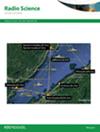电离层不规则和GPS卫星相对动力学对接收机跟踪回路性能的影响
IF 1.6
4区 地球科学
Q3 ASTRONOMY & ASTROPHYSICS
引用次数: 0
摘要
电离层中产生的不规则现象会使平流层卫星信号受到扰动。然而,除了不规则结构的影响外,卫星运动的特征还可能对信号扰动产生额外的影响,这些不规则结构在地磁平静条件下从西向东漂移。本文报道了在电离层闪烁发生期间,全球定位系统卫星几何形状对地面接收器跟踪环路性能的影响。在三个不同的太阳活动期(2014年3月、2015年3月和2022年3月),加尔各答站(22.58°N,88.38°E,地理位置;磁倾角34.54°)位于赤道电离异常北峰附近。根据地面闪烁模式观测,研究了电离层皮尔斯点(IPP)卫星速度的东西分量与失锁持续时间和信号衰落率(<-10dB)的相关性。这项研究的结果显示,在所有三个观测周期内,失锁持续时间与卫星速度向东分量之间的相关性为75%-78%。随后,观测到与向西的卫星速度相对应的较短的失锁持续时间。信号衰落率随着卫星速度的增加而降低,衰落率累积分布百分比的中值对应于2014年3月、2015年3月和2022年3月期间卫星速度分别为16.69、31.76和19.14m/s。这项研究的结果还表明,即使在弱到中等闪烁期间,IPP卫星速度的方向和分量也是信号中断的主要原因。本文章由计算机程序翻译,如有差异,请以英文原文为准。
Effects of the relative dynamics of ionospheric irregularities and GPS satellites on receiver tracking loop performance
Transionospheric satellite signals are exposed to perturbation, caused by irregularities generated in the ionosphere. However, the characteristics of the satellite motion can have an additional impact on signal perturbation, in addition to the effects of irregularity structures, that drift from west to east during geomagnetic quiet conditions. This paper reports the effect of Global Positioning System satellite geometry, on tracking loop performance of ground-based receivers, during occurrence of ionospheric scintillations. Observations are made from station Calcutta (22.58°N, 88.38°E geographic; magnetic dip 34.54°), located near the northern crest of Equatorial Ionization Anomaly, during three different solar activity periods (March 2014, March 2015, and March 2022). Efforts have been made to study the correlation of east-west component of satellite velocity at Ionospheric Pierce Point (IPP) with duration of loss-of-lock and rate of signal fading (<−10 dB), from ground scintillation pattern observations. Results of this study show 75%–78% correlation between duration of loss-of-lock and eastward component of satellite velocity, for all three period of observation. Subsequently, shorter duration of loss-of-lock has been observed corresponding to satellite velocity being westward. Signal fading rate is found to decrease with increasing satellite velocity, having median value of the fading rate cumulative distribution percentage, corresponding to satellite velocity of 16.69, 31.76, and 19.14 m/s respectively during March 2014, March 2015, and March 2022. Results of this study also indicate direction and component of satellite velocity at IPP to be a dominant cause of signal outage, even during periods of weak to moderate scintillations.
求助全文
通过发布文献求助,成功后即可免费获取论文全文。
去求助
来源期刊

Radio Science
工程技术-地球化学与地球物理
CiteScore
3.30
自引率
12.50%
发文量
112
审稿时长
1 months
期刊介绍:
Radio Science (RDS) publishes original scientific contributions on radio-frequency electromagnetic-propagation and its applications. Contributions covering measurement, modelling, prediction and forecasting techniques pertinent to fields and waves - including antennas, signals and systems, the terrestrial and space environment and radio propagation problems in radio astronomy - are welcome. Contributions may address propagation through, interaction with, and remote sensing of structures, geophysical media, plasmas, and materials, as well as the application of radio frequency electromagnetic techniques to remote sensing of the Earth and other bodies in the solar system.
 求助内容:
求助内容: 应助结果提醒方式:
应助结果提醒方式:


